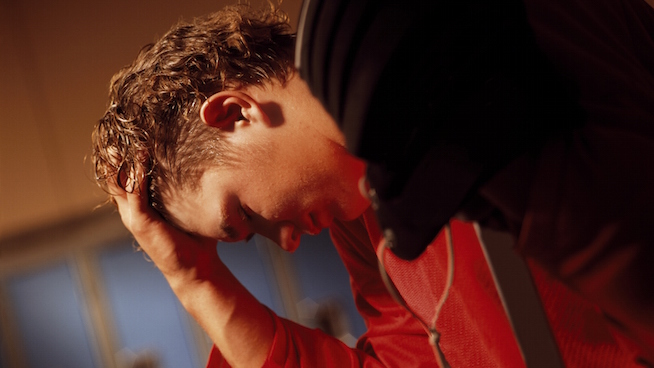Get Fit on the Beach With This Sand Conditioning Workout
![]()
Sand training is one of the best ways for athletes to improve their overall conditioning. The soft sand provides a low impact surface that’s easy on the body, resulting in a safer workout. Because sand is a soft, unstable substance, your lower body—especially your ankles and feet—become stronger because of the greater force needed to move around. This translates to developing stronger legs, which results in a more powerful body capable of exerting greater amounts of force into the ground.
RELATED: WATCH: NFL Prospects Grind Through the Most Brutal Sand Dune Workout Ever
That’s why sand training for sport-specific conditioning has become a staple in the off-season training programs of elite athletes across a variety of sports, including pros in the NFL, MLB, NHL and NBA (e.g., superstars Russell Westbrook and Kevin Durant, as seen in this video).
There are obviously a number of workouts you can do on sand. However, I particularly like the following two drills, which I feel make best use of this great training surface.
Shuttle Runs
Develop acceleration/deceleration and the ability to change directions rapidly by running short bursts for set distances. This is a popular drill used to train and evaluate athletes in a variety of sports, because those qualities are crucial for sports performance.
RELATED: 3 Drills for Training Speed and Agility in the Sand
How to: Set up two cones 25 yards apart. Two laps to the cone and back count as one round for a total of 200 yards. As your conditioning improves you can shorten the rest between rounds, but as a frame of reference beginners should take 4 minutes of rest between rounds, intermediate athletes 3 minutes and advanced athletes 2 minutes of rest.
Multi-Directional Frog Jumps
This is a jump training exercise used to improve overall athletic performance by increasing lower-body power and the ability to explosively contract the muscles.
RELATED: Fun in the Sun: 5 Sand Drills That’ll Make You Better This Summer
How to: Traditionally, Frog Jumps are done in a linear direction. An athlete starts in a deep squat position with hands on head and either jumps forward & backward or laterally. In this drill, athletes jump in whatever direction we call out during the exercise. This makes it more applicable to sports performance, since it requires shorter reaction times and the ability to explosively change directions.
Sand Workout
- Shuttle Runs – 1×200 yards
- Rest
- Shuttle Runs – 1×200 yards
- Rest
- Multi-Directional Frog Jumps – 3×8 with 1 minute rest between sets.
RECOMMENDED FOR YOU
Get Fit on the Beach With This Sand Conditioning Workout
![]()
Sand training is one of the best ways for athletes to improve their overall conditioning. The soft sand provides a low impact surface that’s easy on the body, resulting in a safer workout. Because sand is a soft, unstable substance, your lower body—especially your ankles and feet—become stronger because of the greater force needed to move around. This translates to developing stronger legs, which results in a more powerful body capable of exerting greater amounts of force into the ground.
RELATED: WATCH: NFL Prospects Grind Through the Most Brutal Sand Dune Workout Ever
That’s why sand training for sport-specific conditioning has become a staple in the off-season training programs of elite athletes across a variety of sports, including pros in the NFL, MLB, NHL and NBA (e.g., superstars Russell Westbrook and Kevin Durant, as seen in this video).
There are obviously a number of workouts you can do on sand. However, I particularly like the following two drills, which I feel make best use of this great training surface.
Shuttle Runs
Develop acceleration/deceleration and the ability to change directions rapidly by running short bursts for set distances. This is a popular drill used to train and evaluate athletes in a variety of sports, because those qualities are crucial for sports performance.
RELATED: 3 Drills for Training Speed and Agility in the Sand
How to: Set up two cones 25 yards apart. Two laps to the cone and back count as one round for a total of 200 yards. As your conditioning improves you can shorten the rest between rounds, but as a frame of reference beginners should take 4 minutes of rest between rounds, intermediate athletes 3 minutes and advanced athletes 2 minutes of rest.
Multi-Directional Frog Jumps
This is a jump training exercise used to improve overall athletic performance by increasing lower-body power and the ability to explosively contract the muscles.
RELATED: Fun in the Sun: 5 Sand Drills That’ll Make You Better This Summer
How to: Traditionally, Frog Jumps are done in a linear direction. An athlete starts in a deep squat position with hands on head and either jumps forward & backward or laterally. In this drill, athletes jump in whatever direction we call out during the exercise. This makes it more applicable to sports performance, since it requires shorter reaction times and the ability to explosively change directions.
Sand Workout
- Shuttle Runs – 1×200 yards
- Rest
- Shuttle Runs – 1×200 yards
- Rest
- Multi-Directional Frog Jumps – 3×8 with 1 minute rest between sets.










